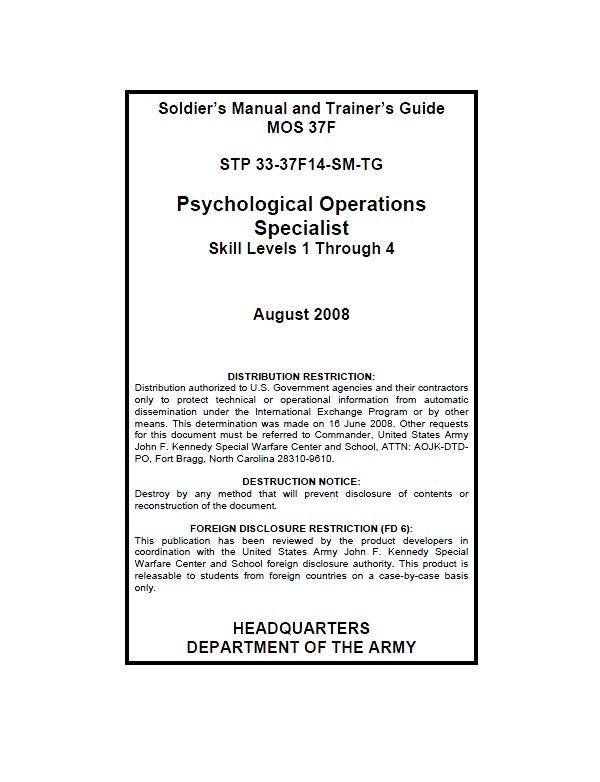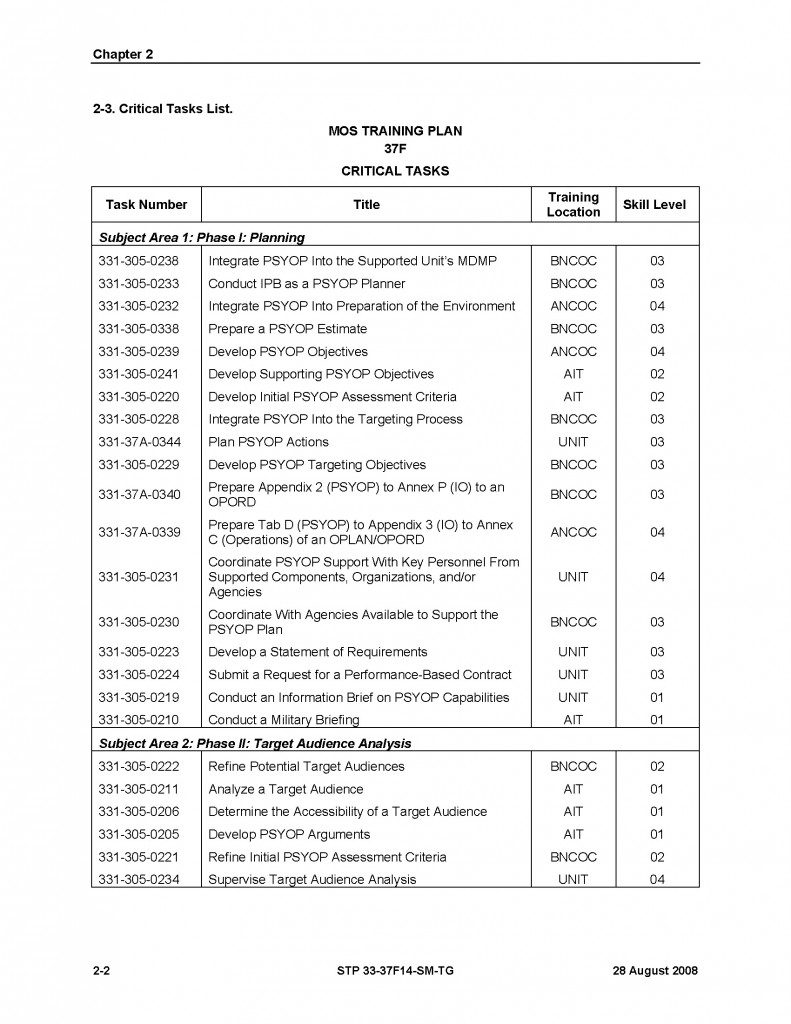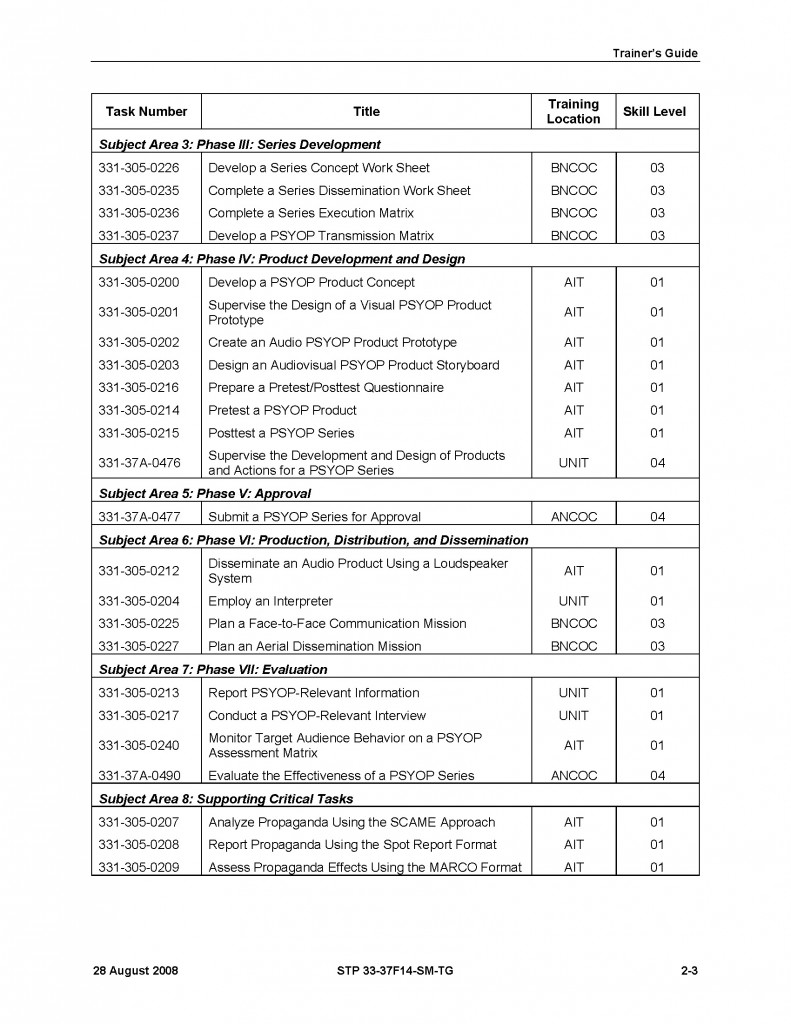Soldier’s Manual and Trainer’s Guide MOS 37F
- STP 33-37F14-SM-TG
- 138 pages
- Distribution authorized to U.S. Government agencies and their contractors only to protect technical or operational information from automatic dissemination under the International Exchange Program or by other means.
- August 2008
This Soldier training publication (STP) is for Skill Levels 1 through 4 Soldiers holding the military occupational specialty (MOS) 37F, Psychological Operations Specialist. It contains standardized training objectives in the form of task summaries to train critical tasks that support unit missions. All Soldiers holding MOS 37F should have access to this publication. This publication applies to the Active Army, the Army National Guard (ARNG)/Army National Guard of the United States (ARNGUS), and the United States Army Reserve (USAR) unless otherwise stated.
…
Conduct Intelligence Preparation of the Battlefield as a PSYOP Planner
331-305-0233Conditions: Given the requirement to plan PSYOP support during mission analysis phase 2, a supported unit’s mission, the higher headquarters’ operation plan, and an area study.
Standards: Integrate PSYOP-relevant information into the supported unit’s mission analysis in accordance with the four-step intelligence preparation of the battlefield (IPB) process.
TASK STEPS AND PERFORMANCE MEASURES
1. Define the battlefield environment by determining significant characteristics of the physical, informational, and cognitive dimensions of the information environment.
a. Establish the limits of the area of interest.
b. Determine the political aspects.
(1) Leadership.
(2) Organizations.
(3) Political system.
(4) Legal system.
(5) Political climate.c. Determine the military/security aspects.
(1) Leadership.
(2) Organizations.d. Determine the economic aspects.
(1) Production.
(2) Distribution.
(3) Consumption.e. Determine the social aspects.
(1) Groups, subgroups, social system, and society.
(2) Demographics and education.
(3) Attitudes, behavior, values, and beliefs.
(4) History and religion.
(5) Language, ethnicity, and culture.f. Determine the information aspects.
(1) Global information systems (international memberships and information technology sources).
(2) National information subsystems (mass communication media—amplitude modulation [AM], frequency modulation [FM], short wave [SW], and satellite radio; television; print; and Internet—and audiences).
(3) Defense information subsystems (military command, control, and communication).g. Determine the infrastructure and technology aspects.
(1) Utilities.
(2) Transportation.
(3) Industry.
(4) Public facilities.h. Determine the environmental/physical aspects.
(1) Geography.
(2) Weather.…
Refine Potential Target Audiences
331-305-0222Conditions: Given the requirement to begin target audience analysis, supported commander’s operation plan/operation order, a blank target audience analysis work sheet (TAAW), the PSYOP estimate, the PSYOP tab/appendix, PSYOP objectives, supporting Psychological Operations objectives (SPOs), and potential target audience (TA) analysis list.
Standards: Identify TAs able to accomplish a specific SPO.
TASK STEPS AND PERFORMANCE MEASURES
1. Identify the primary actors (TAs engaging in [or likely to engage in] the targeted behavior [SPO]).
2. Identify the secondary actors (TAs directly or indirectly influencing the behavior of the primary actors).
3. Identify the subcategories among the primary and secondary actors.
a. Organizations (military units; political, religious, social, or advocacy groups; charities; professional associations).
b. Demographic sets (geographic area, gender, age, ethnicity, and tribe).
c. Leaders.
d. Key communicators.…



